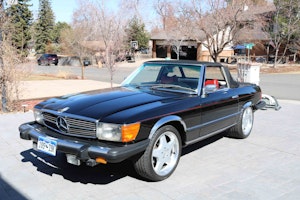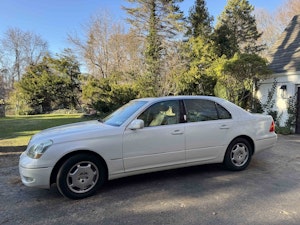Media | Articles
The 25 hottest collector vehicles to kick off 2019
Yes, the Ford Bronco continues to kick up its heels as the hottest collector vehicle in the land. And yes, the majority of the vehicles at the top of the latest Hagerty Vehicle Rating are trucks and SUVs. But passenger vehicles are closing the gap. Cars claimed 11 of the top 26 spots in the newest HVR ranking, which is two more cars than last time around and four more than the time before that.
Big news, right? Is this a comeback story? Nope. Keep on truckin’. Rinse and repeat.
“It’s important to remember that cars far outnumber trucks in terms of what we track, so some cars were bound to sneak back in there at some point,” says Hagerty valuation editor Andrew Newton. “Trucks are still strong, and overall they haven’t slowed.”

Note: The Hagerty Vehicle Rating is based on a 0–100 scale. A 50-point rating indicates that a vehicle is keeping pace with the market overall. Ratings above 50 indicate above-average appreciation, while vehicles below a 50-point rating are lagging behind the market. The rating is data driven and takes into account the number of vehicles insured and quoted through Hagerty, along with auction activity and private sales results. The HVR is not an indicator of future collectability, but it certainly says something about what’s trending hot and what’s not.
Marketplace
Buy and sell classics with confidence
The reigning HVR champion, the 1966–77 Bronco, actually gained two points and sits atop the list with 98—five points ahead of the second-place 1973–91 Chevy Suburban, which moved up from third. The Bronco has scored the #1 ranking three times in a row.
“It can get a little wearisome talking about how hot the first-generation Bronco is, but the numbers don’t lie and buyers are still willing to pay big bucks for the best examples,” Newton says. “The Scottsdale auctions showed that to still be the case, and Chevy Blazers had a huge showing in Scottsdale too. Expect those to be high on the list soon.”

Rounding out the top five with 92 points apiece are the 1993–2002 Mazda RX-7 (up from fourth), the 1993–95 Ford SVT Lightning pickup (up from fifth), and the second-generation 1964–67 Chevrolet El Camino, which increased its total by 12 points and vaulted to fifth from 48th. Newton attributes the El Camino’s upswing to rising values and its strength in the private market, although he pointed out that “Oddly, they haven’t been doing as well at auction.”
While we’re talking about El Caminos, the 1978–87 generation made the largest jump of any vehicle in the Top 25. Fueled by increased insurance activity and a rise in HPG values, the fifth-gen El Camino gained 25 points and leaped from 270th into a tie for 24th with 80 points. Newton wonders if it might be “because more people are starting to look at these as collectible rather than just used-up old pickups.”
With that said, the 1973-87 Chevrolet C/K Series pickup lost six points and slid from second position into a tie for 13th. Although the C/K remains strong overall with 89 points, it has been hurt by poor auction activity, suggesting that its time in the spotlight may have brought out some lower-quality examples that simply haven’t sold well.
Turning our focus from trucks and SUVs, the aforementioned 1993–2002 Mazda RX-7 just keeps climbing. The RX-7—which Newton previously described as a “technical marvel” and “one of the most attractive cars of that decade”—has scored between 91–97 points seven consecutive times. And this time around, it brought one its older siblings along for the ride. The original 1979–85 Mazda RX-7 gained eight points (improving to 91) and jumped from 41st place into a tie for sixth.

“The first-gen RX-7 got a lot pricier with our latest valuation update, and it was also one of the biggest winners of 2018 in terms of value increases,” Newton says. “These were very inexpensive cars for a long time, and for the most part they still are, so as we register more interest from buyers and increased prices, it only takes a few hundred bucks to make a big price surge, percentage-wise.”
For those of you who were miffed by the absence of the Porsche 911 in the last HVR, the 1978–83 and 1990–94 models both fought their way back into the Top 25 and are tied for 13th with 89 points each. The 1978–83 911 (aka the 911SC) was previously 29th, so it didn’t have as far to go.
“It has been on the rise and has had a high HVR for a while, but a big bump in value with the latest price update pushed it into the top 25,” Newton explains. “For a long time, these were one of the affordable ways into air-cooled 911 ownership, so people who were priced out of other eras started turning to the SCs.”

The 1990–94 (964) 911, on the other hand, roared back from 106th position—with a 15-point jump—by outperforming the rest of the market in three categories: auction results, buyer interest, and insurance activity. The 964’s values are also up.
“It shows there’s still room for growth in air-cooled 911s,” Newton says. “Not long ago, the (1994–98) 993 version of the 911 was one of the hottest cars on the market, so maybe the 964 was just overlooked a bit. The 993 currently has a rating of only 29, so it has had its time in the sun. More people seem to be looking to 964s, particularly special models like Turbos, RS Americas, and Speedsters.” At this point we should state, again, that a lower HVR ranking doesn’t necessarily mean a car is doing poorly in the collector market, just that’s it’s not rising with the overall tide. In the case of many a Porsche, values shot up the last few years and have since stabilized.
Also joining the Top 25 are the 1990–99 BMW 8-Series (E31), the 1971–93 Rolls-Royce Corniche, and—hello, old friend—the 1949-67 Volkswagen Beetle, which cracked the list for the first time since… ever?


“The only Beetles that are prettier and most desirable than these are the earlier ones (1946–48),” Newton says. “There have been some strong auction results for well-restored ’49–67 cars. While really good examples—particularly convertibles—have gotten a bit expensive after some big growth over the past year, driver-quality hardtops are still pretty affordable.” [For example, a 1965 VW Beetle in #3 (Good) condition has an average value of $10,200.]
Another VW, the 1990–94 Corrado, remained in the Top 25 following an impressive jump from 327th to 19th last time around. With 89 points, the Corrado is now tied for 13th. Although fewer than 100,000 were built during a seven-year production run, the German liftback coupe has an average #3 value of $5750, making it one of the most affordable “hot” vehicles.
Speaking of affordability, 21 of the top 26 have an average value of $19,200 or less. Eight are valued below $10K. The most expensive cars are the 1978–83 Porsche 911 ($41,500) and 1990–94 911 ($38,000). Overall, the addition of the two 911s and the 1971–93 Rolls-Royce Corniche ($34,150) raised the average value of the top vehicles from $13,423 to $16,206.










